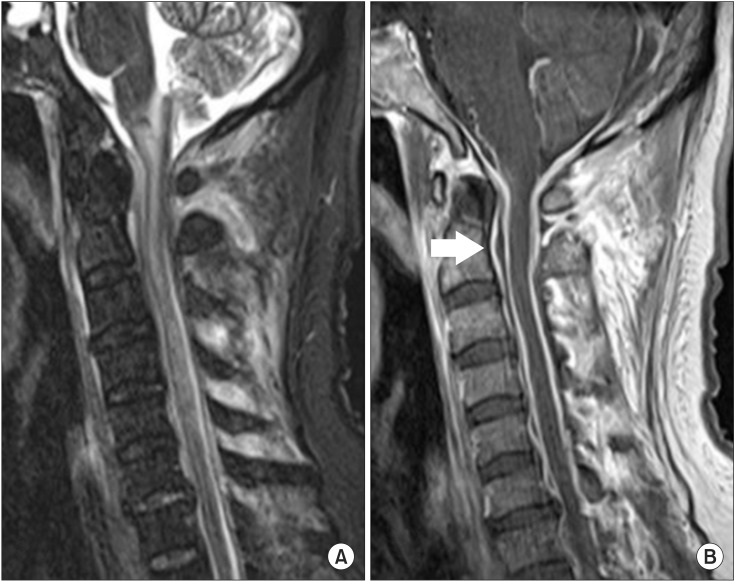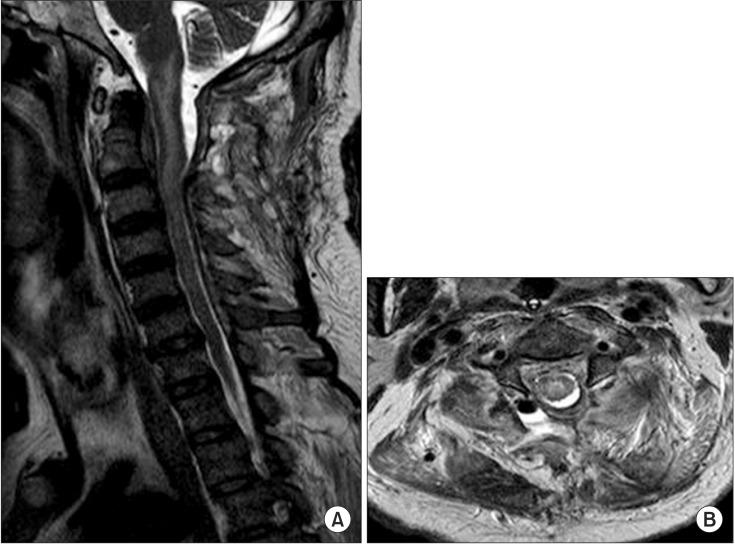Ann Rehabil Med.
2015 Jun;39(3):504-507. 10.5535/arm.2015.39.3.504.
Cervical Meningomyelitis After Lumbar Epidural Steroid Injection
- Affiliations
-
- 1Department of Rehabilitation Medicine, St. Vincent's Hospital, The Catholic University of Korea College of Medicine, Suwon, Korea. completeleeyu@gmail.com
- KMID: 2165657
- DOI: http://doi.org/10.5535/arm.2015.39.3.504
Abstract
- Epidural steroid injections (ESI) are a common treatment for back pain management. ESI-related complications have increased with the growing number of procedures. We report a case of cervical meningomyelitis followed by multiple lumbar ESI. A 60-year-old male with diabetes mellitus presented to our hospital with severe neck pain. He had a history of multiple lumbar injections from a local pain clinic. After admission, high fever and elevated inflammatory values were detected. L-spine magnetic resonance imaging (MRI) revealed hematoma in the S1 epidural space. Antibiotic treatment began under the diagnosis of a lumbar epidural abscess. Despite the treatment, he started to complain of weakness in both lower extremities. Three days later, the weakness progressed to both upper extremities. C-spine MRI revealed cervical leptomeningeal enhancement in the medulla oblongata and cervical spinal cord. Removal of the epidural abscess was performed, but there was no neurological improvement.
Keyword
MeSH Terms
Figure
Reference
-
1. Manchikanti L, Pampati V, Falco FJ, Hirsch JA. Assessment of the growth of epidural injections in the medicare population from 2000 to 2011. Pain Physician. 2013; 16:E349–E364. PMID: 23877459.2. Brisby H. Pathology and possible mechanisms of nervous system response to disc degeneration. J Bone Joint Surg Am. 2006; 88(Suppl 2):68–71. PMID: 16595447.
Article3. Abdi S, Datta S, Lucas LF. Role of epidural steroids in the management of chronic spinal pain: a systematic review of effectiveness and complications. Pain Physician. 2005; 8:127–143. PMID: 16850050.4. Joshi SM, Hatfield RH, Martin J, Taylor W. Spinal epidural abscess: a diagnostic challenge. Br J Neurosurg. 2003; 17:160–163. PMID: 12820759.
Article5. Kim EJ, Moon JY, Park KS, Yoo DH, Kim YC, Sim WS, et al. Epidural steroid injection in Korean pain physicians: a national survey. Korean J Pain. 2014; 27:35–42. PMID: 24478899.
Article6. Even JL, Crosby CG, Song Y, McGirt MJ, Devin CJ. Effects of epidural steroid injections on blood glucose levels in patients with diabetes mellitus. Spine (Phila Pa 1976). 2012; 37:E46–E50. PMID: 21540770.
Article7. Nanjayan SK, Swamy GN, Yallappa S, Bommireddy R. Arachnoiditis following caudal epidural injections for the lumbo-sacral radicular pain. Asian Spine J. 2013; 7:355–358. PMID: 24353855.
Article8. Byun YS, Kim HT, Chang SA, Lee SR, Hwang DH, Kim SH. Iatrogenic spinal infection after injection therapy in spine. J Korean Soc Spine Surg. 2006; 13:299–305.
Article
- Full Text Links
- Actions
-
Cited
- CITED
-
- Close
- Share
- Similar articles
-
- Management of Cervical Radiculopathy with Epidural Steroid Injection
- Persistent Hiccup after Epidural Steroid Injection: Case reports
- Comparison of Transforaminal Epidural Steroid Injection and Lumbar/Caudal Epidural Steroid Injection for the Treatment of Lumbosacral Radiculopathy
- Epidural Steroid Injection in the Treatment of Cervical Radiculopathy
- Accidental Subdural Injection during Attempted Cervical Epidural Block: Radiologic Evidence : A case report




